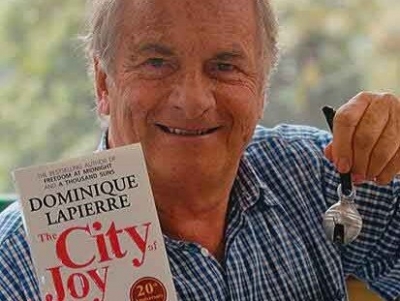
French author Dominique Lapierre used a mix of reportage and historical narrative to spin stories of everlasting appeal. As the “City of Joy” and the world mourns the loss of the writer, here’s a recap of his life and times.
What separates a journalist from an activist? Where is that thin line that you cross over to become part of the story, rather than write the story? More often than not, journalists struggle with the sense of purpose when they report from a battlefield or during catastrophes being faced with the dilemma whether to help the victims or focus on reportage. French author Dominique Lapierre was in the midst of major political upheavals and poignant moments in history, whilst also reporting from war zones. When the journalist turned into an author, and turned these narratives into best-selling books, he ensured that a part of the royalties would be used for humanitarian work.
The literary world mourned as Lapierre breathed his last on December 4. Kolkata also wept, shedding tears with the world. The author who became a household name after he wrote the 1985 novel ‘The City of Joy’ was 91 when he passed away due to age-related issues. The news was confirmed by his wife Dominique Conchon-Lapierre.
Early years
Born on July 30, 1931, in Chatelaillon, France, Lapierre was born to a diplomat father and a journalist mother. He started off the journey as a writer by writing travelogues. He later started reporting for the weekly news magazine “Paris Match” in the 1950s.
Literary partnership
It was whilst he was serving in the French army that he met American Larry Collins. Lapierre was 23 then. Collins later became a journalist. The two subsequently formed a deep literary partnership that propelled them to churn out hugely successful novels.
Six bestselling books!
The collaborative literary works of Lapierre and Larry Collins saw immense success. In all, 50 million copies of the six books Lapierre wrote along with Collins have been sold. These six bestsellers are O Jerusalem! (1972); Freedom at Midnight (1975); Is Paris Burning? (1965), The Fifth Horseman (1980); Is New York Burning? (2005); and Or I’ll Dress You In Mourning (1968).
Lapierre’s ode to India
Lapierre always had a special connection with India. He showed his love for India even through his memoir, India mon amour (2010). But it was his novel The City of Joy that made him popular with the Indian crowd. The story revolves around the experiences of a rickshaw puller. In a PTI interview, Lapierre had said that the novel was like his “song of love for India, the place where I have been coming very regularly since the last 50 years. It has been an emotional journey for me where I have got a lot of love and support from the people”.
Five Past Midnight in Bhopal: The Epic Story of the World’s Deadliest Industrial Disaster (1997) is yet another book written by him. This was an investigative account of the 1984 Bhopal gas tragedy based on three years of research and interaction with survivors. This he wrote in collaboration with Javier Moro. In 2008, he was awarded India’s third-highest civilian award, the Padma Bhushan.
A humanitarian
Lapierre was all about writing with a purpose. As a writer and journalist, he leaves behind a legacy. What we know is that Lapierre didn’t stop with documenting the injustices but also tried his bit to address them.
His humanism is evident in how he founded the “City of Joy Aid”, a non-profit humanitarian organisation based in Kolkata in 1981. He donated a large share of his royalties to support humanitarian projects. He supported many charitable projects in India such as refuge centres for children affected with polio, NGOs, schools, rehabilitation workshops, education programmes, and so on. Likewise, the royalties from the sale of the book on the Bhopal gas tragedy were used to give free medical treatment to the victims of the disaster.
Books to movies
Is Paris Burning? and The City of Joy were later made into movies by René Clément in 1966 and Roland Joffé in 1992 respectively.
Picture Credit : Google




